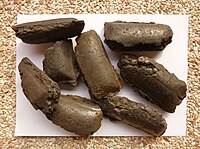
Photo from wikipedia
Direct reduction of low-grade iron ore pelleted with coal was investigated using a pilot-scale rotary kiln. The evolution of the iron minerals, the strength of the pellets, and the emission… Click to show full abstract
Direct reduction of low-grade iron ore pelleted with coal was investigated using a pilot-scale rotary kiln. The evolution of the iron minerals, the strength of the pellets, and the emission characteristics were measured. The results showed that the rotary kiln could be divided into three major functional zones: reduction of hematite to wüstite occurred at 1023–1163 K; wüstite transformed to fine metallic iron particles at 1163–1318 K; and metallic iron particles aggregated within 6.5 m of the outlet. The product had a metallization ratio of 92%. Pellet strength was maintained at 30–45 N within the first zone and no disintegration occurred. Aggregation of metallic iron particles within the final zone improved the strength to 465 N. The reduced sample was treated by grinding followed by magnetic separation. Of the total iron in the ore, 85.61% was recovered as iron powder (grade: 92.0 mass%). Use of this process could reduce CO 2 emissions by approximately 10%.
Journal Title: JOM
Year Published: 2020
Link to full text (if available)
Share on Social Media: Sign Up to like & get
recommendations!